Feb 22, 2023
How One New Mexico County is Taking a Community-Wide Approach to Treating Alcohol and Substance Use Disorders
 Sheryl Livingston
can't recall a time when alcohol use wasn't visible in
her hometown of Gallup, New Mexico.
Sheryl Livingston
can't recall a time when alcohol use wasn't visible in
her hometown of Gallup, New Mexico.
"It's always been a huge problem," said Livingston, a licensed clinical mental health counselor who grew up on the Navajo Nation reservation on the outskirts of Gallup and now works as a behavioral health specialist at Gallup Indian Medical Center (GIMC). "And it impacts everybody."
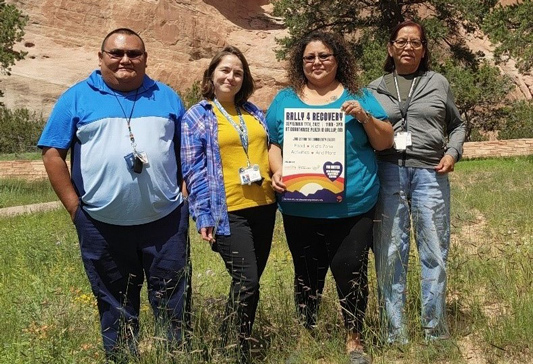
McKinley County, where Gallup is located, has the highest rate of alcohol deaths per capita in New Mexico, the state with the highest rate of alcohol deaths per capita in the U.S. As an expert counselor in the local hospital's emergency department, Livingston has a firsthand view of the challenges around alcohol and substance use in McKinley County — and the work that has been done in the community to address these challenges head-on.
A community-wide consortium to improve health outcomes for residents of McKinley County who have a history of, or are at risk of developing, substance use disorders is the latest step taken by local healthcare leaders to tackle an issue that has been present in Gallup for generations. The consortium brings together a range of organizations and entities to take a holistic approach to recovery, from withdrawal management to peer counseling to assistance accessing housing and other basic needs.
It's our goal to build a continuum of services so that we can promote lifelong recovery — not just treat a person for five days and send them back into their environment.
"It's our goal to build a continuum of services so that we can promote lifelong recovery — not just treat a person for five days and send them back into their environment," said Barry Ore, Program Director for Four Corners Detox Recovery Center in Gallup.
A longtime challenge
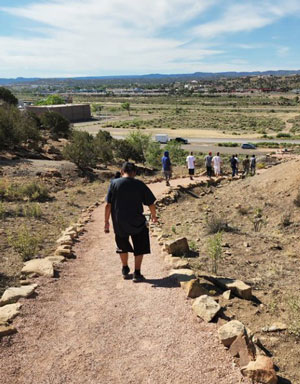
McKinley County, which has approximately 70,000 residents, contains parts of two reservations — the Navajo Nation and the Pueblo of Zuni — within its limits. The sale of alcohol is prohibited within the Navajo Nation. But it is legal to buy and sell alcohol in the town of Gallup, which borders the reservation.
Jennie Wei, MD, an internal medicine and addiction medicine physician in Gallup and one of the founders of the consortium, traces widespread alcohol and substance use in McKinley County to the history of the region.
"I think part of the way that some people have learned to cope with all… that has happened to our [tribal] communities is through alcohol, unfortunately," Wei said. "It's one of the biggest challenges that we have facing our community."
The Na'Nizhoozhi Center, a detox facility in Gallup first opened in the 1990s, has helped to keep some demand off of the limited resources of Gallup's hospitals and emergency departments, Wei said. But when the COVID-19 pandemic hit Gallup and the rest of the U.S. in 2020, the virus spread quickly in the close quarters of the detox facility and other shelters, contributing to disproportionately high rates of infection in McKinley County.
It's a story that unfortunately has been written time and time again.
"It's a story that unfortunately has been written time and time again," Wei said. "The pandemic brought to the forefront how important it is for us to be addressing all of the other social [factors] that lead to a devastating response to something like COVID — the importance of housing, and access to healthcare, and to treatment for substance use."
Collaboration and advocacy
Over the past five years or so, Livingston says she's noticed the issue of alcohol and substance use become gradually "more open" — and less taboo — in the Gallup community.
"Especially now, in the last three years, there's been much more advocacy for our community members who struggle with that," Livingston said.
Prior to the COVID pandemic, McKinley County had formed a county-wide Alcohol Task Force that met monthly and included representatives from the local hospitals, the detox facility, housing entities, an intimate partner violence program, and the Gallup Police Department. When the pandemic hit, the task force leapt into action, creating a "COVID hotel" program that served more than 1,850 people who otherwise would have needed to be housed in congregate shelters or the detox facility.
"All of us had already been working closely together, so we were able to respond quickly," Wei said. "That was a huge success, and definitely mitigated what could have been an even worse problem."
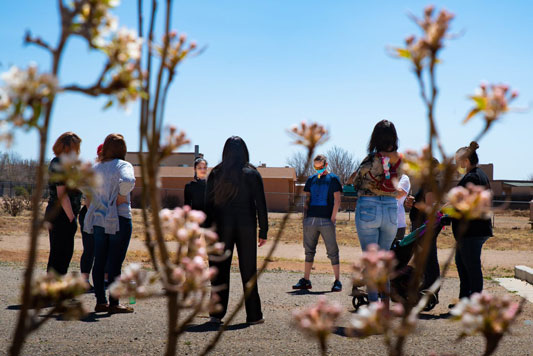
When the Santa Fe-based Santa Fe Recovery Center opened a new facility in Gallup — the Four Corners Detox Recovery Center — in late 2020, the community's options for addressing alcohol and substance use expanded further. The Center offers a five-day detox program and a 30-day, 24-7 structured program that includes counseling, case management, and daily activities; after that point, clients can choose whether to continue into a 90-day extended program or take advantage of a range of outpatient services.
"There's a continuum of services that our organization directly offers, and then a wider continuum across the community," Ore said. "That's what the consortium's about: coming together as a community to provide the whole range of services that an individual needs."
Multi-pronged treatment
Formed in 2021 with support from a Health Resources and Services Administration (HRSA) Rural Health Care Services Outreach Program grant, the community consortium's primary members include Four Corners Detox Recovery Center, Navajo Area Indian Health Services, Rehoboth McKinley Christian Health Care Services, the New Mexico Human Services Department's Behavioral Health Services Division, and the Hozho Center for Personal Enhancement, a local nonprofit providing resources and support to those going through recovery.
Other partners include the Gallup Community Pantry — an organization that includes a food pantry and community garden, where Four Corners clients perform community service — and the Lexington Hotel, a shelter in Gallup that provides affordable housing and case management to people experiencing homelessness.
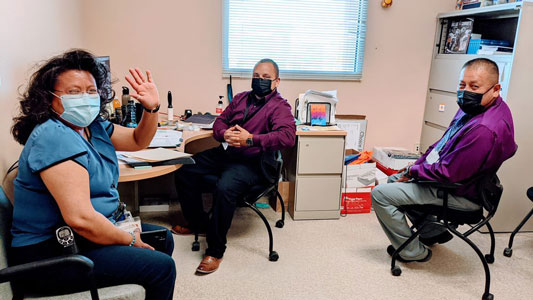
The consortium was created with the understanding that "an alcohol use disorder is something people can struggle with for their whole life," Wei said. She compared the treatment of alcohol use disorder to the treatment of chronic conditions, such as high blood pressure, that require patients to be on medications long-term.
"If you were to stop [a high blood pressure patient's] medication, their blood pressure would go up and they would be at increased risk for heart attack and stroke," Wei said. "Similarly, with alcohol use disorder, it can be a lifelong disease that requires continuous treatment."
It's also important that other stressors or comorbid disorders — such as housing insecurity, or mental illnesses — be treated at the same time as the alcohol use disorder, Wei noted.
It's not about, 'First, you stop your drinking, and then we can treat you for your depression, and then we can get you housing.'It all has to be happening together to really be effective. And I think we as a community are coming to understand the importance of all of that.
"It's not about, 'First, you stop your drinking, and then we can treat you for your depression, and then we can get you housing,'" Wei said. "It all has to be happening together to really be effective. And I think we as a community are coming to understand the importance of all of that."
At monthly meetings, members discuss progress made on the project's grant goals — which include expanding the delivery of substance use disorder-related healthcare services, utilizing community engagement, and improving population health in a demonstrable way — and collaborative opportunities. Most recently, consortium members partnered with the Gallup Magistrate Court to create a treatment court program.
"Those are the sort of collaborative efforts that are really challenging, but that grant funding has helped us to achieve," Ore said.
A personalized approach
The consortium also holds biweekly calls for local hospitals and other community providers to identify "high utilizers": people who are "slipping through the cracks, whose needs aren't getting met, and who are utilizing the most expensive services" such as emergency department visits and ambulance rides, according to Ore.

One "high utilizer" discussed during these calls had been admitted to the emergency department more than 60 times the previous year and begun the Four Corners Detox Recovery Center's detox program at least six times, Ore said, without lasting results.
"The pattern was that this person would come in and not really engage — he'd come in for a day or two and then leave," Ore said. "That was the cycle. His needs just weren't quite being met."
Through their biweekly conversations, consortium members were able to come up with a new treatment strategy for this particular man: incorporating his love of art into his recovery by providing him with art supplies while he was in treatment. This time, the man made it all the way through Four Corners' 30-day residential treatment program before being placed in an aftercare and housing program — and gifted Four Corners' CEO a piece of homemade artwork in thanks.
"The trajectory of that one life changed, and this also had a huge significance for the community and the limited resources that we have," Ore said.
Deepening cultural understanding
In the 11 years that she's worked as a counselor at GIMC, Livingston says she's noticed a shift in attitudes toward addiction, both in the community and among healthcare providers.
A decade ago, "there was a lot of moral judgment" on people experiencing addiction, Livingston said. "'You could stop if you wanted to,' and those types of perceptions, when it actually is very hard for patients to do that."
Livingston attributes the shift largely to the arrival of Wei and a handful of other doctors at GIMC with expertise in addiction medicine and an active interest in changing that narrative.
"With their education and the care and compassion that they had, there were a lot of changes that were made here in the hospital that linked out into the community," Livingston said.
The current slate of physicians at GIMC has also prioritized improving their own understanding of local culture, Livingston said. Livingston has conducted several trainings on how to better communicate with patients and encourage them to seek help, and how to identify patients whose struggles with substance or alcohol use may not be immediately obvious.
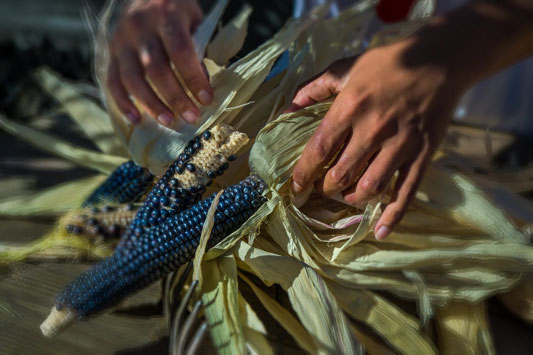
Growing up in a Navajo family, Livingston recalls times as a child when her parents were hesitant to visit the hospital — "even, at times, not trusting to go to the hospital because of that cultural difference and barrier."
In McKinley County today, healthcare providers are "constantly talking about" those differences, Livingston said, with regular meetings held at GIMC on how to make all patients feel safe and comfortable seeking medical treatment.
Making patients feel safe and understood is also a priority for the broader community consortium: With grant funding, the consortium created an outreach team of peer support workers, all of whom are local to the McKinley County area and some of whom speak the Navajo and Zuni languages.
"There's something really special about lived experience that births an amount of empathy and understanding that would take somebody else years and years of training to try to reach," Ore said. "And so it's easier to build rapport with our clients."
The peer support workers conduct outreach sessions at local shelters and the local detention center, as well as providing support to people who are already in recovery. All are trained in support strategies that include Motivational Interviewing, a counseling method that focuses on internal motivation; and Comprehensive Community Support Services, a model of case management that helps patients learn practical new skills and access community resources.
We're bringing evidence-based practices to a rural community and merging that with the traditional cultural practices of the region.
"We're bringing evidence-based practices to a rural community and merging that with the traditional cultural practices of the region," Ore said.
A gradual build
It's difficult to measure the consortium's impact in numbers, less than two years in. But the impact of Gallup's recently expanded services can be seen on an individual level, Wei said.
"There are patients who say the treatment they've gotten, and the ability to get linked to services and people they feel really understand them, has changed their life," Wei said. "I have patients who have been sober for the first time in decades, just by feeling that they have a safe place to go and get resources and start to understand a little bit about where their trauma has been coming from."
Wei and Ore both emphasize that this work hasn't been done overnight: The consortium would likely not be as effective, they say, had the foundation for collaboration not already been laid through the McKinley County Alcohol Task Force and other efforts.
"Relationship building takes a lot of work, and it's an ongoing thing," Ore said. "When you're working with people from different disciplines, sometimes you get the sense that you're competing for resources. So it's about maintaining those relationships and remembering that we're all working together."
A similar consortium built from the ground up in a different community might begin with just a handful of interested people, Wei noted.
"Consistency over time will build that trust," Wei said. "Sometimes it literally just takes time. It has nothing to do with your ability or your expertise, and you can't take any of that personally — you just have to recognize that different communities work on a different timeline."
What all communities do share, Wei added, is "richness" waiting to be mined — not of money, but of passion and care.
There's a lot of richness in every community.
"There's a lot of richness in every community," Wei said. "People care about each other. Communities want their neighbors to thrive. There are a lot of people that are doing good work, and it's just a matter of getting those folks together."

